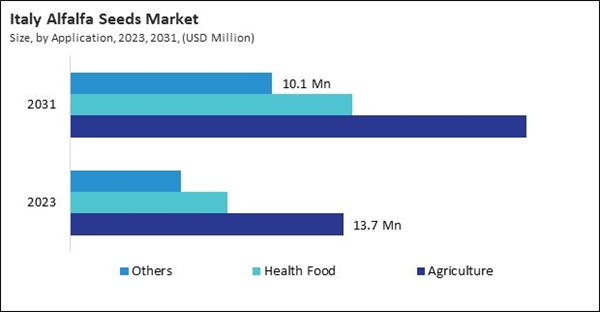Alfalfa seeds are increasingly utilized in various health foods such as salads, sprouts, and smoothies due to their dense nutritional profile, including vitamins, minerals, and antioxidants. Alfalfa sprouts are popular for their crisp texture and mild flavor, making them a versatile addition to salads, sandwiches, and wraps. Additionally, alfalfa seed powder is gaining traction as a functional ingredient in protein shakes, energy bars, and dietary supplements, thanks to its high protein content and amino acid profile. Thus, the health food sector of the UK market utilized 248.80 Tonnes of alfalfa seeds in the market in 2023.
The Spain market dominated the Europe Alfalfa Seeds Market by Country in 2023 and would continue to be a dominant market till 2031; thereby, achieving a market value of $65.4 Million by 2031. The France market is exhibiting a CAGR of 5.6% during (2024 - 2031). Additionally, The Italy market would experience a CAGR of 7.3% during (2024 - 2031).
Alfalfa seeds are the seeds of the alfalfa plant (Medicago sativa), which is a legume species commonly cultivated as a forage crop. These seeds are small, hard, and typically brown or yellowish. Also, alfalfa seeds are used primarily for planting to grow alfalfa crops, which are then harvested for hay, silage, or grazing by livestock. Alfalfa seeds find application across a spectrum of industries, reflecting the versatility and adaptability of this resilient crop. For example, alfalfa seeds are primarily utilized as a high-quality feed ingredient for livestock, including dairy cows, beef cattle, sheep, goats, and horses.
Also, humans consume alfalfa seeds directly due to their nutritional benefits. They can be sprouted and added to salads, sandwiches, wraps, and smoothies, providing a crunchy texture and a mild, nutty flavor. Alfalfa seeds are rich in vitamins (such as vitamin K, vitamin C, and B vitamins), minerals (including calcium, magnesium, and iron), antioxidants (such as flavonoids and phenolic compounds), and phytonutrients, offering numerous health-promoting properties. In addition, alfalfa seeds are commonly used as a cover crop in agricultural systems to improve soil health and prevent erosion.
The expansion of the agri-food sector may lead to changes in crop rotation practices among UK farmers. With its ability to improve soil health, fix nitrogen, and provide high-quality forage, alfalfa may be incorporated into crop rotations more frequently, driving demand for alfalfa seeds. Therefore, the increasing agri-food industry and the region’s high livestock population drive growth.
Based on Type, the market is segmented into Non-Dormant Seed, and Dormant Seed. Based on Application, the market is segmented into Agriculture, Health Food, and Others. Based on countries, the market is segmented into Germany, UK, France, Russia, Spain, Italy, and Rest of Europe.
List of Key Companies Profiled
- Allied Seed, LLC
- Bayer AG
- S&W Seed Company
- Royal Barenbrug Group
- Nutrien Ltd. (Dyna-Gro Seed)
- Great Basin Seed
- DLF Seeds A/S
- Forage Genetics International, LLC
- The Dow Chemical Company
- Syngenta Crop Protection AG
Market Report Segmentation
By Type (Volume, Tonnes, USD Million, 2020-31)- Non-Dormant Seed
- Dormant Seed
- Agriculture
- Health Food
- Others
- Germany
- UK
- France
- Russia
- Spain
- Italy
- Rest of Europe
Table of Contents
Companies Mentioned
- Allied Seed, LLC
- Bayer AG
- S&W Seed Company
- Royal Barenbrug Group
- Nutrien Ltd. (Dyna-Gro Seed)
- Great Basin Seed
- DLF Seeds A/S
- Forage Genetics International, LLC
- The Dow Chemical Company
- Syngenta Crop Protection AG









